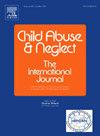在因成骨不全或严重血友病住院前因儿童身体虐待住院:法国一项全国性队列研究
IF 3.4
2区 心理学
Q1 FAMILY STUDIES
引用次数: 0
摘要
背景对儿童早期身体虐待进行及时准确的诊断,对于避免再次发生和保护受害者至关重要。排除鉴别诊断对避免CPA误诊也很重要。我们评估了早期CPA住院前的两种主要鉴别诊断:成骨不全症(OI)和严重血友病(SH)。方法本研究采用法国所有医院的国家行政数据库。我们跟踪了2010年至2019年出生的婴儿,直到他们两岁。我们确定了具有早期CPA、OI和SH首次出院代码的婴儿,并计算了粗绝对和相对风险。结果纳入的6,315,216例婴儿中,2088例(33/10万/年)因早期CPA住院,160例(3/10万)因成骨不全而住院,402例(6/10万)因2岁前SH住院。在婴儿早期CPA住院,2085(99.86%)没有进一步住院OI或SH, 3(0.14%)进一步住院OI的九个月平均住院治疗的时间间隔,和0进一步住院SH。住院的绝对风险早CPA OI的住院为1.9%(3/160,95%可信区间[CI] 0.39 - -5.38),和相对风险与婴儿OI无需住院为56.8 (95% CI 18.5 - -174.3)。结论早期CPA在成骨不全或骨不全之前住院的绝对风险极低至零,这可能反映了目前排除鉴别诊断的良好临床实践。更好地实施现有的指南可以进一步缩短2岁前诊断成骨不全的时间。本文章由计算机程序翻译,如有差异,请以英文原文为准。
Hospitalization for child physical abuse before hospitalization for osteogenesis imperfecta or severe hemophilia: A nationwide cohort study in France
Background
Timely and accurate diagnosis of early child physical abuse (CPA) is crucial to avoid recurrence and protect victims. Ruling out differential diagnoses is also important to avoid misdiagnosis of CPA. We evaluated the risk of hospitalization for early CPA before hospitalization for its 2 main differential diagnoses: osteogenesis imperfecta (OI) and severe hemophilia (SH).
Methods
This population-based cohort study used the national administrative database covering all hospitals in France. We followed infants born from 2010 to 2019 until age 2. We identified infants with a first discharge code for early CPA, OI, and SH and calculated crude absolute and relative risks.
Results
Among the 6,315,216 infants included, 2088 (33/100,000 infants per year) were hospitalized for early CPA, 160 (3/100,000) for OI, and 402 (6/100,000) for SH before age 2. Among infants hospitalized for early CPA, 2085 (99.86 %) had no further hospitalization for OI or SH, 3 (0.14 %) were further hospitalized for OI with a 9-month median interval between hospitalizations, and 0 were further hospitalized for SH. The absolute risk of hospitalization for early CPA before hospitalization for OI was 1.9 % (3/160, 95 % confidence interval [CI] 0.39–5.38), and the relative risk as compared with infants without hospitalization for OI was 56.8 (95 % CI 18.5–174.3).
Conclusions
The very low to null absolute risks of hospitalization for early CPA before OI or SH probably reflect excellent current clinical practices in ruling out differential diagnoses. A better implementation of existing guidelines could further shorten the time to diagnosis of OI before age 2.
求助全文
通过发布文献求助,成功后即可免费获取论文全文。
去求助
来源期刊

Child Abuse & Neglect
Multiple-
CiteScore
7.40
自引率
10.40%
发文量
397
期刊介绍:
Official Publication of the International Society for Prevention of Child Abuse and Neglect. Child Abuse & Neglect The International Journal, provides an international, multidisciplinary forum on all aspects of child abuse and neglect, with special emphasis on prevention and treatment; the scope extends further to all those aspects of life which either favor or hinder child development. While contributions will primarily be from the fields of psychology, psychiatry, social work, medicine, nursing, law enforcement, legislature, education, and anthropology, the Journal encourages the concerned lay individual and child-oriented advocate organizations to contribute.
 求助内容:
求助内容: 应助结果提醒方式:
应助结果提醒方式:


